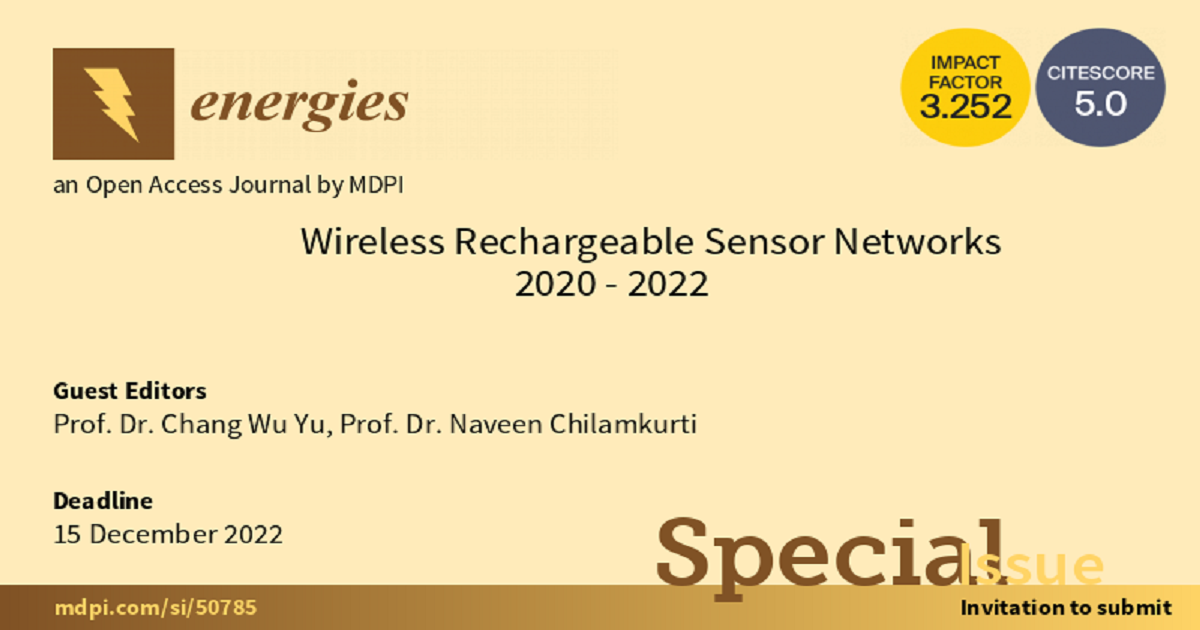Wireless Rechargeable Sensor Networks 2020-2022
A special issue of Energies (ISSN 1996-1073). This special issue belongs to the section "A1: Smart Grids and Microgrids".
Deadline for manuscript submissions: closed (15 December 2022) | Viewed by 6781

Special Issue Editors
Interests: theoretical and fundamental problems in wireless sensor networks; algorithms in wireless sensor networks; graph algorithms
Special Issues, Collections and Topics in MDPI journals
Interests: network security; CPS; sensor network; IoT; AI-based information processing
Special Issues, Collections and Topics in MDPI journals
Special Issue Information
Dear Colleagues,
Wireless sensor networks have recently attracted a great deal of attention due to their various applications in many fields. Due to their limited power consumption, these sensor nodes may experience power shortages and thus lead to many problems, including network disconnection. Most previous methods focused on providing energy-saving strategies to elevate the lifetime of sensor networks. Another aggressive but different approach is to wirelessly re-charge the sensor nodes to increase the lifetime of the sensor networks.
This Special Issue, entitled “Wireless Rechargeable Sensor Networks”, invites articles that address state-of-the-art technologies and new developments for wireless rechargeable sensor networks (WRSNs).
Articles which deal with the latest hot topics in WRSNs are particularly encouraged, such as charger deployment, charger scheduling, wireless energy transfer, mobile charger design, energy-harvesting techniques, and energy provisioning. In addition, articles which discuss protocols, algorithms, and optimization in WRSN are of particular interest.
Prof. Dr. Chang Wu Yu
Dr. Naveen Chilamkurti
Guest Editors
Manuscript Submission Information
Manuscripts should be submitted online at www.mdpi.com by registering and logging in to this website. Once you are registered, click here to go to the submission form. Manuscripts can be submitted until the deadline. All submissions that pass pre-check are peer-reviewed. Accepted papers will be published continuously in the journal (as soon as accepted) and will be listed together on the special issue website. Research articles, review articles as well as short communications are invited. For planned papers, a title and short abstract (about 100 words) can be sent to the Editorial Office for announcement on this website.
Submitted manuscripts should not have been published previously, nor be under consideration for publication elsewhere (except conference proceedings papers). All manuscripts are thoroughly refereed through a single-blind peer-review process. A guide for authors and other relevant information for submission of manuscripts is available on the Instructions for Authors page. Energies is an international peer-reviewed open access semimonthly journal published by MDPI.
Please visit the Instructions for Authors page before submitting a manuscript. The Article Processing Charge (APC) for publication in this open access journal is 2600 CHF (Swiss Francs). Submitted papers should be well formatted and use good English. Authors may use MDPI's English editing service prior to publication or during author revisions.
Keywords
- charging scheduling
- wireless energy transfer techniques
- energy-harvesting technique
- charger and charging pad deployment
- protocol design
- mobile charger design
- energy provisioning
- wireless sensor networks
- flying sensor networks






